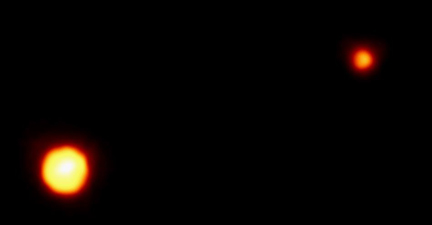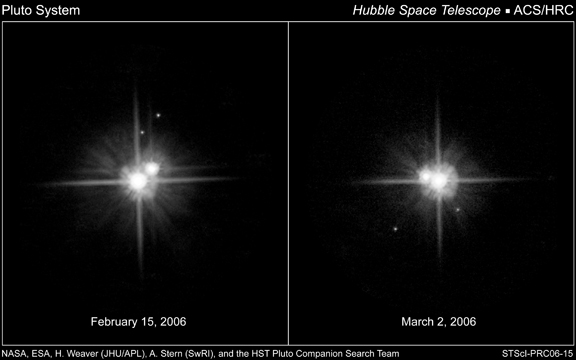Pluto's Moons
Overview
For nearly 50 years, Pluto was thought to be a lone object, circling a seemingly cold and indifferent star, occasionally trading places with the would-be second-farthest planet from the Sun, Neptune.
In 1977, its largest moon, Charon was discovered, and it was quickly realized that Charon was huge relative to the main planet, being fully half its size. In fact, it was found that it was so large that the gravitational center of the two objects is physically outside of the surface of Pluto, between the two objects, causing many people to refer to it as a double planet system.
Then, nearly 30 years later, a team of astronomers from Boulder, CO's Southwest Research Institute discovered two more - tiny - moons that orbit much farther away, bringing the total count to three.
History
Charon's discovery was announced by Captain J.C. Smith of the U.S. Naval Observatory (USNO) on July 7, 1978. It was discovered by James W. Christy of the USNO by looking at photographic plates from the Observatory's 60-inch reflecting telescope at Flagstaff, AZ. It looked like a small pimple growing out of Pluto's side.
It was quickly confirmed to be real by looking at archived photographic plates of Pluto. The images that showed Charon made Pluto look simply slightly elongated, and they had been discarded by other workers as anomalous.
The separation of Pluto and Charon - as seen from Earth - changes between 0.56 arcsec when Pluto is farthest away up to 0.94 arcsec when Pluto is closest. (The full moon is approximately 1800 arcsec across.) When it was discovered, the separation was about 0.9 arcsec. With the telescope technology at the time, this was just on the edge of what was resolvable. With today's adaptive optics systems, astronomers can resolve objects down to less than 0.1 arcsec.
Charon
 |
| Photograph of Pluto and its then-only-known moon, Charon, in 1990 - the clearest picture to-date of the to objects. Image courtesy of the Hubble Site. |
Two pieces of information soon came from Charon. First, once its distance from Pluto and its orbital period were determined, Kepler's Third Law could be used to - for the first time - accurately calculate Pluto's mass. It was originally calculated that the combined mass of Pluto and Charon is 1/430 of Earth's; the current value is about 1/423 of Earth's mass.
The second deals with the dynamics of Pluto and Charon's orbit. Twice throughout Pluto's 248-year period, it and Charon go through a series of transits when one body passes directly in front of the other as seen from Earth. One set of transits happened starting in February 1985, and they continued every 3.2 days until 1990. By very carefully studying the amount of light that was blocked, a map of the dark and light areas of the two bodies could be created. These are the only maps that exist of the two objects.
Originally, Charon was determined by its assumed brightness to be about 10% the mass of Pluto; it is currently believed to have 12% the mass of Pluto, weighing about 1.62x1021 kg. It was also originally believed that it was about 800 km in diameter, and in 1980 this was revised to about 1200 km in diameter when it passed in front of a star on April 7th of that year; it is now believed to be 1212 km (751 miles) in diameter, as measured by the stellar occultation of C313.2 on July 11, 2005. This gives it a mean density of 1.66 gm/cm3, which is larger than the 1.55 it was originally believed to have.
Pluto and Charon are tidally locked, which means that they always present the same face to each other. In other words, Charon's day is exactly as long as its year, so that as it revolves around Pluto, it rotates at exactly the same rate. The system probably evolved into this situation through a process of tidal evolution. The same thing is very slowly happening to Earth and our moon, where the moon is very slowly retreating from Earth, and Earth's rotation rate is very slowly growing longer; eventually, Earth and the moon will be tidally locked, as well.
Also, like our moon, Charon probably formed in a giant impact event with Pluto in the early days of the solar system. When Charon was first discovered, it was believed that it formed by fission - Pluto spun so rapidly that a piece spun off from it. This theory fell out of favor rather quickly, though.
Nix and Hydra
In October of 2005, two candidate moons were discovered in orbit around Pluto (Weaver et al., 2006). They were provisionally called S/2005 P1 and S/2005 P2, and once they were verified by the Hubble Space Telescope on February 15, 2006, they were re-named Hydra and Nix. If they are confirmed to exist with future observations, then the International Astronomical Union will give them official names, probably based upon minor characters associated with the ancient Roman god of the underworld.
 |
| Two images from the Hubble Space Telescope, taken about two weeks apart, showing Pluto (large, center), its main moon Charon (smaller, but just to the side), and its two other known moons, Nix and Hydra. Compilation is from the Hubble Site. |
Assuming that the moons are real, they have been observed to have orbital periods much longer than Charon's. They are also in an approximate 6:4:1 resonance (Hydra:Nix:Charon), though the resonance is not exact.
They are rather small when compared with Pluto and Charon, and they orbit about the center of mass of the Pluto-Charon system rather than about Pluto itself. Because of this, the total mass of the Pluto-Charon system, plus the two moons, has been calculated to be 1.4570±0.0009·1022, which is 3% larger than had been previously determined.
This mass implies that the density of Charon is 1.63±0.07 gm/cm3 and that of Pluto is 2.03±0.06 gm/cm3. The density of Charon was also measured to be 1.71 gm/cm3 based upon a stellar occulation on July 11, 2005, when its radius was also revised upwards by 10 km (Stern et al., 2006). This is less than the previously derived density of Charon, and it is larger than the previously derived density of Pluto. "Official" numbers are still the ones quoted in the tables on this web site, which are based upon what NASA provides.
Colors of the two moons (Nix has a B-V of 0.653±0.026 and Hydra has a B-V of 0.654±0.065) indicate that they are redder than Pluto. The newly discovered satellites are approximately 100 million times fainter than Pluto. All data on the moons in 2005 were taken with the Hubble Space Telescope (Buie et al., 2006).
Based upon further images, it is highly unlikely that Pluto has any more moons that are larger than 10 km (Steffl et al., 2006).
Data
The following table lists data for Pluto's three known moons. Data are gathered from original journal articles cited below in "References."
| Charon | Nix | Hydra | |
|---|---|---|---|
| Semi-Major Axis (103 km) | 19.5714±0.004 | 48.675±0.121 | 64.78±0.088 |
| Orbital Inclination (from Haumea's Equator) | 96.145±0.014° | 96.18±0.022° | 96.36±0.12° |
| Orbital Eccentricity | 0.000000±0.000070 | 0.0023±0.0021 | 0.0052±0.0011 |
| Average Axis Radius (km) | 606.0±1.5 | 22-65 | 22-65 |
| Mass (1015 kg) | 1,620,000 | 100-9000 | 100-9000 |
| Density (water=1 g/cm3) | |||
| Sidereal Orbital Period (hours) | 153.3 | 596.5 | 917.0 |
| Geometric Albedo | 0.38 | 0.04-0.4 | 0.04-0.4 |
| Visual Magnitude | |||
| Discoverer | J.W. Christy | Weaver et al. (2006) | Weaver et al. (2006) |
| Discovery Date | 1977 | Oct. 2005 | Oct. 2005 |